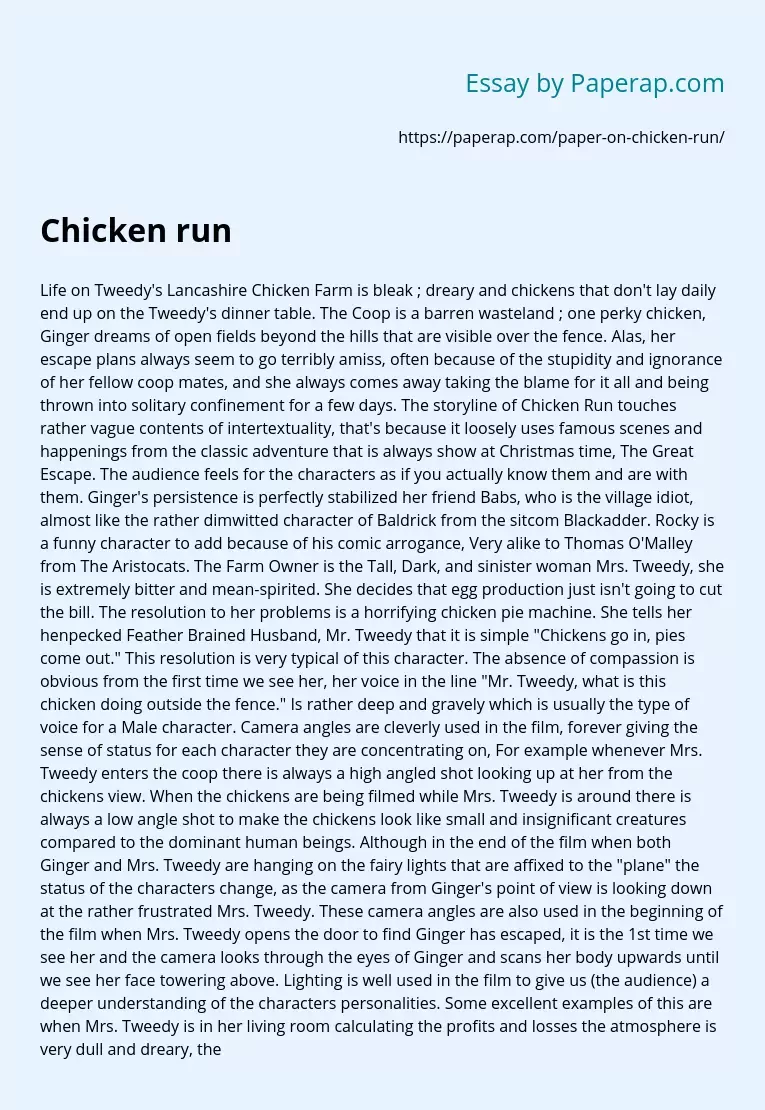Chicken Run Movie Summary and Analysis
Life on Tweedy’s Lancashire Chicken Farm is bleak ; dreary and chickens that don’t lay daily end up on the Tweedy’s dinner table. The Coop is a barren wasteland ; one perky chicken, Ginger dreams of open fields beyond the hills that are visible over the fence. Alas, her escape plans always seem to go terribly amiss, often because of the stupidity and ignorance of her fellow coop mates, and she always comes away taking the blame for it all and being thrown into solitary confinement for a few days.
The storyline of Chicken Run touches rather vague contents of intertextuality, that’s because it loosely uses famous scenes and happenings from the classic adventure that is always show at Christmas time, The Great Escape.
The audience feels for the characters as if you actually know them and are with them. Ginger’s persistence is perfectly stabilized her friend Babs, who is the village idiot, almost like the rather dimwitted character of Baldrick from the sitcom Blackadder.
Rocky is a funny character to add because of his comic arrogance, Very alike to Thomas O’Malley from The Aristocats.
The Farm Owner is the Tall, Dark, and sinister woman Mrs. Tweedy, she is extremely bitter and mean-spirited. She decides that egg production just isn’t going to cut the bill. The resolution to her problems is a horrifying chicken pie machine. She tells her henpecked Feather Brained Husband, Mr. Tweedy that it is simple “Chickens go in, pies come out.” This resolution is very typical of this character.
The absence of compassion is obvious from the first time we see her, her voice in the line “Mr. Tweedy, what is this chicken doing outside the fence.” Is rather deep and gravely which is usually the type of voice for a Male character.
Camera angles are cleverly used in the film, forever giving the sense of status for each character they are concentrating on, For example whenever Mrs. Tweedy enters the coop there is always a high angled shot looking up at her from the chickens view. When the chickens are being filmed while Mrs. Tweedy is around there is always a low angle shot to make the chickens look like small and insignificant creatures compared to the dominant human beings. Although in the end of the film when both Ginger and Mrs. Tweedy are hanging on the fairy lights that are affixed to the “plane” the status of the characters change, as the camera from Ginger’s point of view is looking down at the rather frustrated Mrs. Tweedy. These camera angles are also used in the beginning of the film when Mrs. Tweedy opens the door to find Ginger has escaped, it is the 1st time we see her and the camera looks through the eyes of Ginger and scans her body upwards until we see her face towering above.
Lighting is well used in the film to give us (the audience) a deeper understanding of the characters personalities. Some excellent examples of this are when Mrs. Tweedy is in her living room calculating the profits and losses the atmosphere is very dull and dreary, there is hardly any light what so ever, all the furniture is all made of dark wood which will not reflect any light. Another example is when the pie machine arrives in the barn it is a bleak room with the light and reflection of Mrs. Tweedy’s face reflecting off of the sharp, sinister looking blade as it spins violently.
Overall the use of theatrical elements is manipulated extremely well to reveal the true personality and life style that the characters in this movie lead.
Chicken Run Movie Summary and Analysis. (2018, Dec 16). Retrieved from https://paperap.com/paper-on-chicken-run/

